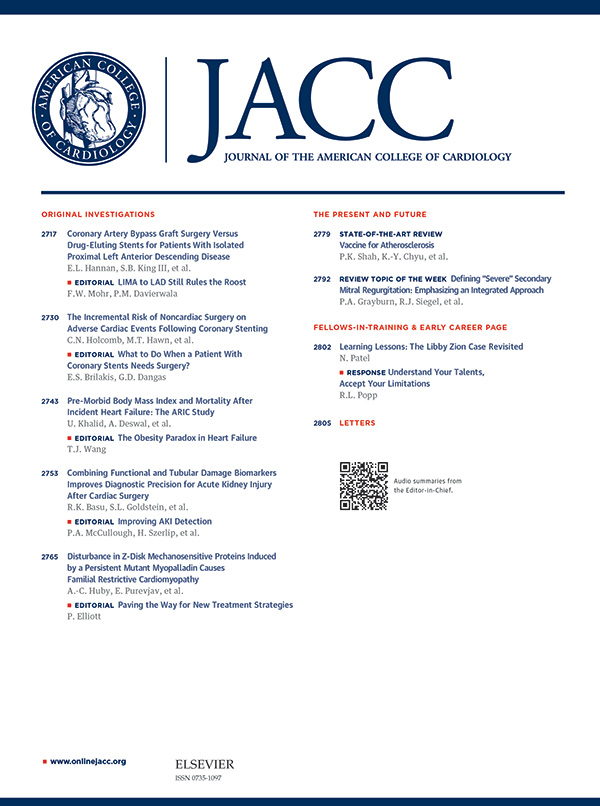5-Year Outcomes After Transcatheter or Surgical Aortic Valve Replacement in Low-Risk Patients With Aortic Stenosis
IF 21.7
1区 医学
Q1 CARDIAC & CARDIOVASCULAR SYSTEMS
引用次数: 0
Abstract
Background
The Evolut Low Risk trial demonstrated that transcatheter aortic valve replacement (TAVR) was noninferior to surgery for the primary endpoint of all-cause mortality or disabling stroke at 2 years. Outcomes at 5 years have not been reported.Objectives
This study sought to evaluate 5-year clinical and hemodynamic outcomes with TAVR vs surgery in patients from the Evolut Low Risk trial.Methods
We randomly assigned low-risk patients with severe aortic stenosis to TAVR or surgery. The primary endpoint was a composite of all-cause mortality or disabling stroke. Secondary endpoints included clinical, echocardiographic, and quality-of-life outcomes through 5 years.Results
A total of 1,414 patients underwent an attempted implant (n = 730 TAVR, n = 684 surgery). The mean age was 74 years (range 51-88 years), and women accounted for 35% of patients. At 5 years the Kaplan-Meier estimate for the primary endpoint of all-cause mortality or disabling stroke was 15.5% for the TAVR group and 16.4% for the surgery group (P = 0.47). The Kaplan-Meier estimates in the TAVR and surgery groups for all-cause mortality were 13.5% and 14.9% (P = 0.39) and for disabling stroke were 3.6% and 4.0% (P = 0.57). Cardiovascular mortality was 7.2% in the TAVR group and 9.3% in the surgery group (P = 0.15). Noncardiovascular mortality in the TAVR group was 6.8% and 6.2% in the surgery group (P = 0.73). A site-level vital status sweep was performed for patients who were lost to follow-up or withdrew from the study. With the addition of these patients, the all-cause mortality rate at 5 years for patients undergoing TAVR was 14.7% and for surgery was 15.2% (P = 0.74). Over 5 years, valve reintervention rate was 3.3% for TAVR and 2.5% for surgery (P = 0.44). A sustained improvement in quality of life was observed in both treatment arms with mean Kansas City Cardiomyopathy Questionnaire summary score of 88.3 ± 15.8 in TAVR and 88.5 ± 15.8 in surgery.Conclusions
At 5 years, patients with severe aortic stenosis who were treated with either TAVR or surgery had comparable rates of all-cause mortality or disabling stroke. Valve durability and performance were excellent in both arms. This midterm evaluation reinforces the position of TAVR as noninferior to surgery in patients with severe aortic stenosis at low surgical risk (Medtronic Evolut Transcatheter Aortic Valve Replacement in Low Risk Patients; NCT02701283)

求助全文
约1分钟内获得全文
求助全文
来源期刊
CiteScore
42.70
自引率
3.30%
发文量
5097
审稿时长
2-4 weeks
期刊介绍:
The Journal of the American College of Cardiology (JACC) publishes peer-reviewed articles highlighting all aspects of cardiovascular disease, including original clinical studies, experimental investigations with clear clinical relevance, state-of-the-art papers and viewpoints.
Content Profile:
-Original Investigations
-JACC State-of-the-Art Reviews
-JACC Review Topics of the Week
-Guidelines & Clinical Documents
-JACC Guideline Comparisons
-JACC Scientific Expert Panels
-Cardiovascular Medicine & Society
-Editorial Comments (accompanying every Original Investigation)
-Research Letters
-Fellows-in-Training/Early Career Professional Pages
-Editor’s Pages from the Editor-in-Chief or other invited thought leaders

 求助内容:
求助内容: 应助结果提醒方式:
应助结果提醒方式:


